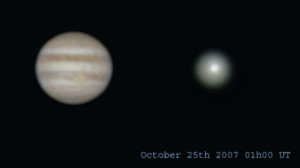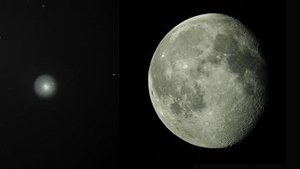
|
| Click on above photo for animation. |
The diaphanous and curiously spherical cloud surrounding the comet's core is now large enough to physically swallow the King of Planets!
And that's just for starters. The growing comet subtends an angle (4 arcminutes) as large as the Moon's Sea of Tranquillity. Last night in Higham Ferrers, England, Dave Eagle photographed "the Moon and Comet Holmes with the same setup to show how big this strange comet is."

|
Although the comet is not as bright as Jupiter or a lunar mare, it is visible to the unaided eye. Look north after sunset for a magnitude +2.5 fuzzball in the constellation Perseus: sky map.
What would make a comet explode in this fashion? Actually, a better question is, what would make a comet explode twice in this fashion? This is the second time Comet 17P/Holmes has erupted. The first was in 1892, an outburst that led to the comet's discovery by British astronomer Edwin Holmes.
The answer may be sinkholes. There is growing evidence that some comets and asteroids may have a porous internal structure akin to, say, swiss cheese or a honycomb. Suppose one of the chambers of the honycomb suddenly collapsed, exposing many square kilometers of fresh cometary ice to sunlight for the first time. A flurry of sublimation would ensue with mega-jets of dusty gas emerging from the sinkhole to create a cloud around the comet much as we see now. Twice = two sinkholes, one in 1892 and one in 2007. (Many readers have asked if the explosion might be a result of a cosmic collision. Perhaps an asteroid hit the comet. While possible, such an event is unlikely to happen once and it is unlikely2 to have happened twice.)
Because no one can see the comet's nucleus--it is small, far away and hidden inside a Jupiter-sized debris cloud--this "explanation" is no more than conjecture. The true events at the core of Comet Holmes remain unknown. Grab your telescope and savor the mystery!



Reader Comments
to our Newsletter